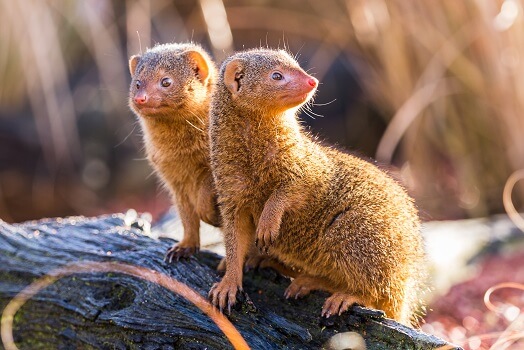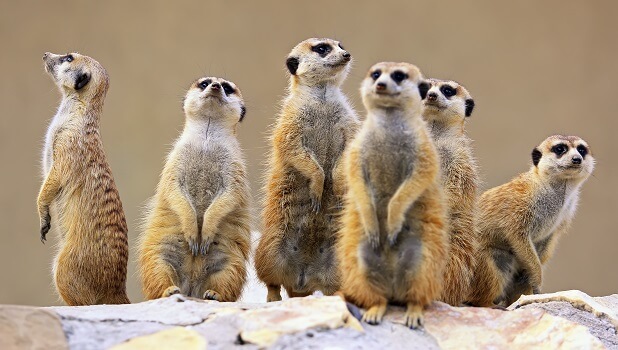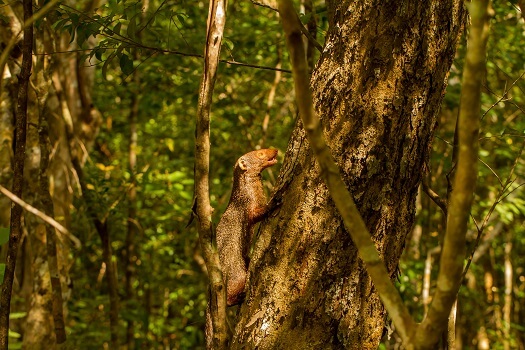
The mongoose is a small carnivore that is mainly found in Africa, although some species are found in southern Asia and southern Europe. These small mammals are bold predators that are well known for their attacks on highly venomous snakes such as the king cobra. There are 33 species belonging to 14 genera. Mongooses vary in size considerably with the smallest being the dwarf mongoose (Helogale parvula) whose body measures just seven to ten inches (17 – 24cm) in length, with its tail adding an extra six to eight inches (15 – 20cm). In contrast, the largest mongoose is the white-tailed mongoose, and its body measures between 19 and 28 inches (48 – 71 cm). Its tail can be up to 18.5 inches (47 cm) long. Mongooses are grey to brown, with some species having specific markings including darker legs, pale or ringed tails, and stripes. They have short legs, a long, pointy nose, and small ears. These animals have a varied diet, feeding on small mammals, birds, reptiles, eggs, and insects. Some species supplement their diet with fruits, nuts, and seeds, and several mongooses are known to attack and kill venomous snakes! Each mongoose species has adapted to the particular ecosystem in which they live. Most species are terrestrial and are active during the day. Some species, however, are semiaquatic and a few are at home in the trees. Many mongoose species make their homes in burrows and tunnels that they have either dug themselves or that they find abandoned. For the most part, mongooses live alone or in pairs, although some species – such as the banded mongoose (Mungos mungo) and meerkats (Suricata suricatta) – live in large groups. The main threat to all mongoose species is habitat loss. Deforestation and the conversion of land for agriculture reduces the habitat in which they live. The use of pesticides and an increase in pollution also poses a threat. Mongooses are also the victim of the pet trade and many are caught and traded and in some countries, they are used in roadside shows where they are forced to fight with snakes. Indian grey mongoose (Herpestes edwardsi) – native to the Indian subcontinent and West Asia, this mongoose inhabits open forests, scrublands, and farmers’ fields. This species is known for its ability to fight with venomous snakes such as the cobra. Meerkat (Suricata suricatta) – also known as the suricate, this small mongoose is found in southern Africa. They live in large communities which consist of several families. They work together, with a few generally working as lookouts while the rest forage for food. If danger is spotted, a meerkat will sound a sharp, shrill call that will warn the others to take cover. Egyptian mongoose (Herpestes ichneumon) – native to the Iberian Peninsula, this mongoose is found in coastal regions along the Mediterranean between North Africa and Turkey. As well as birds and mammals, these mongooses also hunt insects by putting their noses to the ground and sniffing until they locate them. Then they either wait for the insects to surface and snatch them up, or they dig them out from the dirt. Banded mongoose (Mungos mungo) – found all across Africa, from the Sahel to southern Africa, this mongoose lives in large groups ranging from seven to 40 individuals. They commonly use termite mounds to make their den. As this species lives in large colonies, they prefer to live in dens that have multiple entrances that provide easier access and ventilation. Found mainly in Africa and southern Asia, mongooses are small, agile mammals that are fearless hunters. Some species are extremely social and live in large communities, while others live alone. Different species have different biological adaptations that have enabled them to persist in various habitats! Let’s take a closer look at some of them. The mongoose is a fast and daring animal and several species are known for their ability to fight and eat venomous snakes. This agile animal uses its speed to tire the snake out by enticing it to strike and darting away. Once the snake it tired, the mongoose can overcome it and uses its powerful bite to crack the snake’s skull. Aside from being quick, mongooses have thick skin and fur which provides some protection from a snake’s fangs. Sometimes a mongoose will get bitten but scientists have found that they are immune to the snake’s venom! How does this work? Well, when an animal is bitten by a snake and venom is injected, one of the molecules in the venom, alpha-neurotoxin, attaches itself to receptor molecules that are found on the surface of cells in a muscle. These receptors are important because they receive messages from nerves that tell the muscles to contract or relax. The alpha-neurotoxin in the snake’s venom blocks the receptors from receiving these messages which results in paralysis and ultimately the victim dies. In mongooses, these receptors are shaped differently which makes it impossible for the snake venom to bind to them and block these messages. This means that the muscle cells can still receive messages and so the snake venom causes them no harm. The Indian grey mongoose is famous for its ability to take on venomous snakes and has even been known to tackle the king cobra! Dwarf mongooses have the most unlikely hunting partner – hornbills. These birds are often found foraging with mongoose groups – but what exactly is the benefit? Well, the birds provide an extra lookout system for the mongooses, warning them if danger is approaching. In return, the hornbills benefit from the insect prey that is dug up by the mongooses when they are foraging. What is even more interesting about this relationship, is that the mongoose’s tiny pups will also run around with the hornbills. Surprisingly, the hornbills do not attempt to eat them even though they are the size of other small mammals that the hornbills prey upon. In some regions, these birds have even been observed waiting outside the mongooses’ den in the morning so that they can start feeding together! Many animals work together in mutualistic relationships – a relationship where both animals receive a benefit. Another example of this is the oxpecker (a type of bird) and the rhinoceros or zebra. The birds eat ticks, flies, and other insects found on these animals, providing the birds with food and the larger animals with relief from pests. Some mongoose species have an interesting adaptation when it comes to the birth of their pups. The females give birth several times a year and all the females in the same community will give birth on the same day! The females synchronize these births to ensure that their offspring survive. If the pups are born early, they are at risk of being killed by the other females in the group while their mom is out hunting. The other females will do this to reduce the competition for their offspring’s survival. This behavior is instinctive as it enables a female’s pups to survive if resources are scarce. The pups that are born together remain in the burrows until they are approximately six weeks old. Males will stand guard at the entrance to the burrow while the females go out hunting, to ensure that the pups are protected. Males that have not reproduced form bonds with the young male pups, teaching them how to forage and hunt for food as well as how to defend themselves. These mentors are usually older brothers, cousins, or uncles. The females will stay together as a bonded group which can last for their entire lifetime.
Kingdom
Animalia
Phylum
Chordata
Class
Mammalia
Order
Carnivora
Family
Herpestidae
Genus
14
Species
33
Length
Body 7 – 25 in (17.8 – 63.5 cm); tail 6 to 21 in (15.2 – 53.3 cm)
Weight
Up to 11 lbs (approximately 5 kg)
Lifespan
6 – 10 years (Up to 20 in captivity).
Social Structure
Some species are solitary, some live in pairs, some large groups
Status
Most mongoose species are listed as threatened
Habitat
Forets, open grassland and savannahs, fields and forests
Average litter size
2 – 4
Main food item
Small mammals, birds, snakes, eggs, and fruits.
Main predators
Birds of prey, snakes, leopards, and jackals.
The Basics

Mongoose Species
Fun Facts about the Mongoose!
Fighting with Snakes!

Dwarf Mongooses Forage with Hornbills

Synchronized Births
